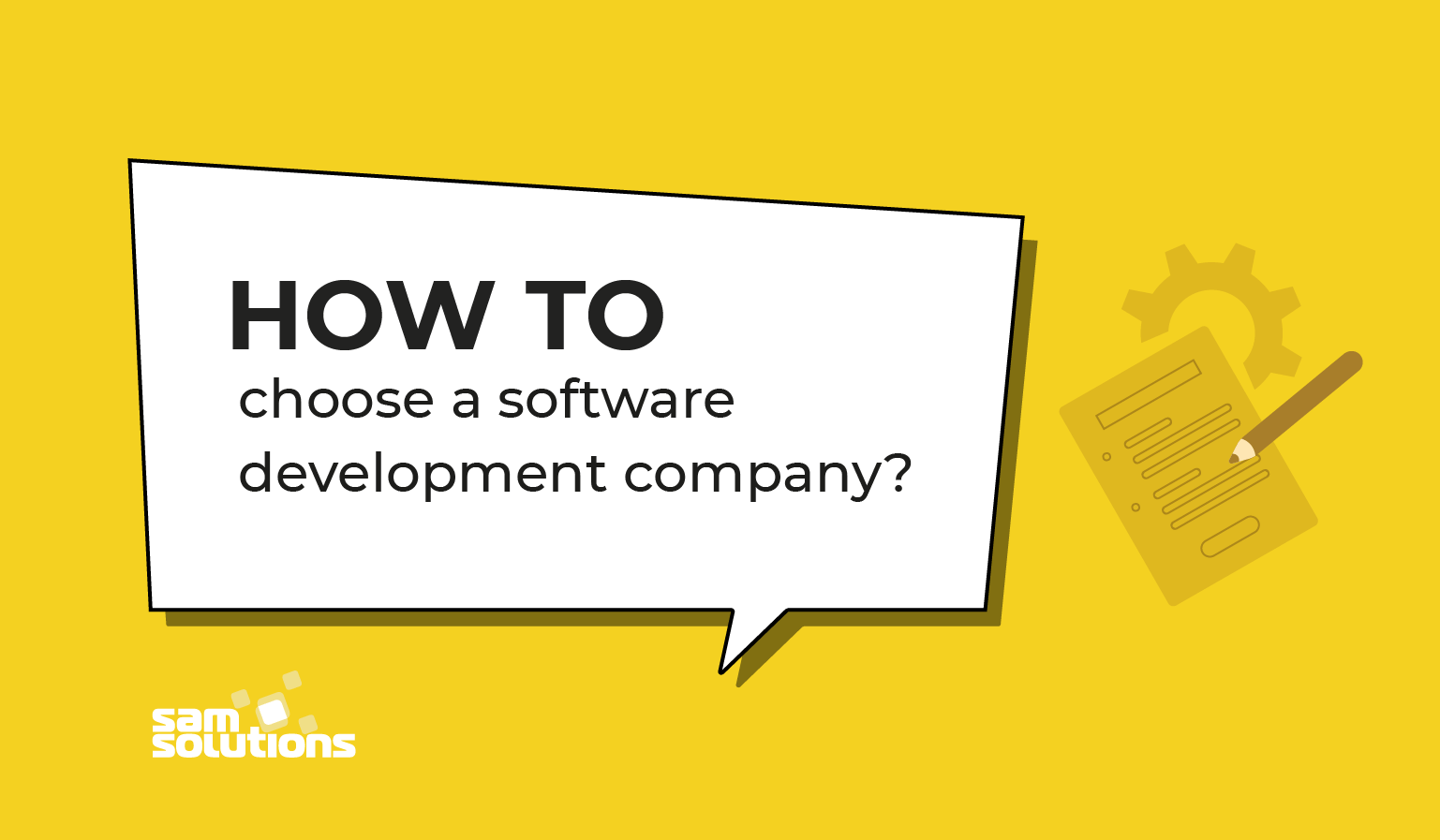Introduction
Over the recent years, there has been a significant growth in software development outsourcing. The survey conducted by Statista shows that 92 percent of respondents worldwide outsource their IT services.
And that’s no surprise. Outsourcing software development offers a bunch of benefits such as cost savings, improved product quality, and opportunity to focus on your company’s core business.
Therefore, if you want to create your own software, consider hiring a software development outsourcing company. For example, you can work with our company, SaM Solutions, and we’ll make it easy and secure.
In this post, you’ll learn (click on the links to jump to a specific section):
- what software development outsourcing is;
- 3 key benefits of outsourcing software development;
- 4 major challenges of software development outsourcing;
- 3 common software outsourcing engagement models;
- 5 simple tips to efficiently outsource your software activities;
- where to order outsourcing and how much it costs;
- how to pick the right software vendor.
What Is Software Development Outsourcing
To put it simply, outsourcing is a business practice in which a company hires a vendor to provide services for the company instead of using its in-house resources (i.e. insourcing, for example hiring new employees). Outsourcing has become the mainstream for companies in almost every industry. Specifically, businesses often outsource call service functions and financial functions such as bookkeeping and payroll processing.
According to Statista’s report, when it comes to the tech industry, the most commonly outsourced IT function is software development.
What services can be outsourced
As we can see from the above picture, you can outsource not only software development but also other IT functions, such as:
- migration to the cloud;
- application replatforming, optimization and modernization;
- custom software solutions;
- software application maintenance and support;
- business analysis;
- software quality audit;
- quality assurance and testing;
- systems integration;
- service desk / help desk functions.
Outsourced IT functions have traditionally been divided into two categories: infrastructure outsourcing and application development outsourcing.
Infrastructure outsourcing, as the name suggests, is subcontracting the management of an organization’s IT infrastructure (physical systems such as hardware, storage, any kind of routers/switches, networks, and often the building itself) to an outside vendor. In particular, this includes data center outsourcing, service desk capabilities, systems integration, network services, and the overall infrastructure management.
On the other hand, application development outsourcing refers to outsourcing the development of business applications. This can involve most stages of the application lifecycle (specifically, the design, testing, release or production of applications), as well as consulting and related services.
However, in today’s cloud-based world, IT outsourcing can also include relationships with software-, infrastructure-, and platform-as-a-service providers.
Types of outsourcing
Businesses can choose not only which IT functions to outsource, but also the outsourcing destination, which can be onshore, nearshore or offshore, depending on the distance from the hiring company. Let’s consider this in detail.
Onshore software outsourcing. This is hiring a service provider within an organization’s own country (for US companies, this is the US). The model can be briefly called “onshoring”/”homeshoring”.
The benefit of onshore outsourcing is that there are virtually no language barriers, making communication much easier and, ultimately, outsourcing more effective. However, customers may have to pay substantially more for development as well.
Nearshore software outsourcing. This model means that IT services are outsourced to a neighboring country, which frequently shares a border with your own, or to one in the same time zone. Also known as “nearshoring”. With nearshoring, you have no or little time difference, little cultural gaps, while the cost of services can be lower due to better rates in nearby countries.
Example (for U.S. companies): Mexico, Argentina.
Offshore software outsourcing. IT functions are outsourced to a distant country, usually overseas. This is the most cost-effective option due to lower labor costs in the offshore country. On the downside, communication between the company and a vendor can be hard because of language barriers and cultural differences.
Example (for U.S. companies): Poland and Lithuania in Eastern Europe or India and the Philippines in Asia.
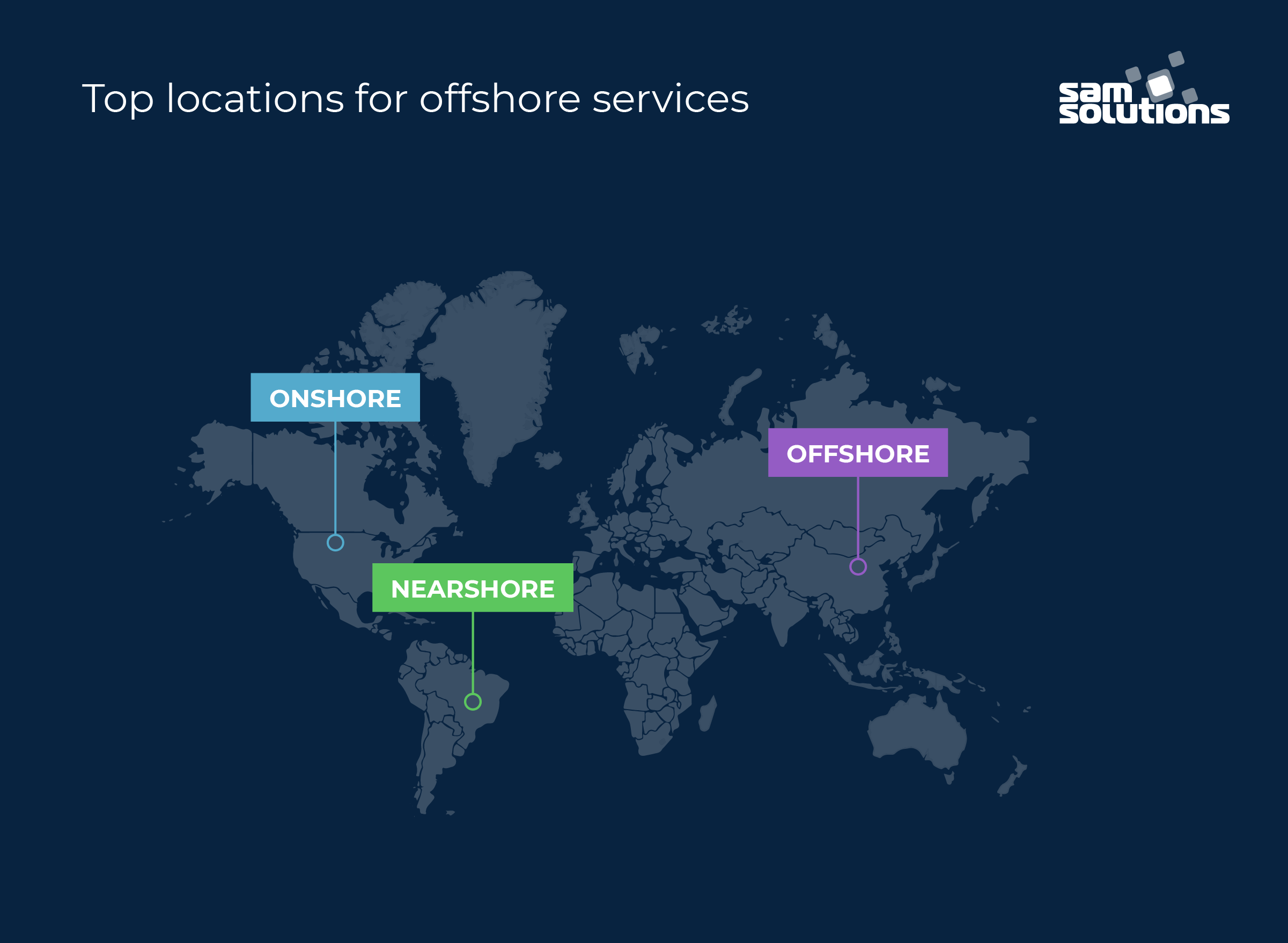
4 Key Benefits of Outsourcing Software Development
- Cost savings
- Access to the global IT talent pool
- Freeing up human resources within the company
- Enhancement of the company’s operations and/or customer focus
Let’s consider these advantages in detail.
Cost savings
In most cases, this is the main reason why companies outsource their software development instead of hiring an in-house team.
With outsourcing, you don’t have to spend money on a lengthy recruitment process, training of new hires, provision of employee benefits and health insurance, as well as securing additional infrastructure, office space and equipment.
This is particularly true for nearshore or offshore outsourcing. Under this strategy, you can take advantage of the difference in the cost of living in developing and developed countries.
For instance, the cost of living in New York or London is way higher than in Eastern European countries, which have established themselves as reliable outsourcing locations. A lower cost of living typically proportionately translates into lower compensation.
For example, according to Payscale, the average salary of a software developer in the USA is $88k per year, while in Poland it is just about $24k.
Cost savings are especially important when you have a tight budget (e.g. you are a startup or small or medium-sized business) and you cannot afford hiring a permanent in-house software developer in your local market.
Greater focus on your core business process
You don’t repair your shower yourself when it’s leaking, right? Instead, you call a plumber to get it fixed.
As a business, outsourcing software development to an external dedicated team will help you free up your schedule and resources to focus on what you do better than others, on your core competencies, and take the time to become the best in these areas. This creates value that cannot be copied or replicated by anyone else, laying the foundation for better sales and higher revenues.
Access to larger pools of IT talent
The IT industry is now on the rise and every year requires more and more skilled staff. As a result, the market has become more competitive and the competition for tech talent has intensified recently in many countries, especially in Western Europe and the US.
The good news is that with outsourcing, you no longer have to recruit within the small radius of your office or wait for a local IT guy to get out of his current job. Instead, you’ve got remote access to countless skilled developers around the world that can handle your project.
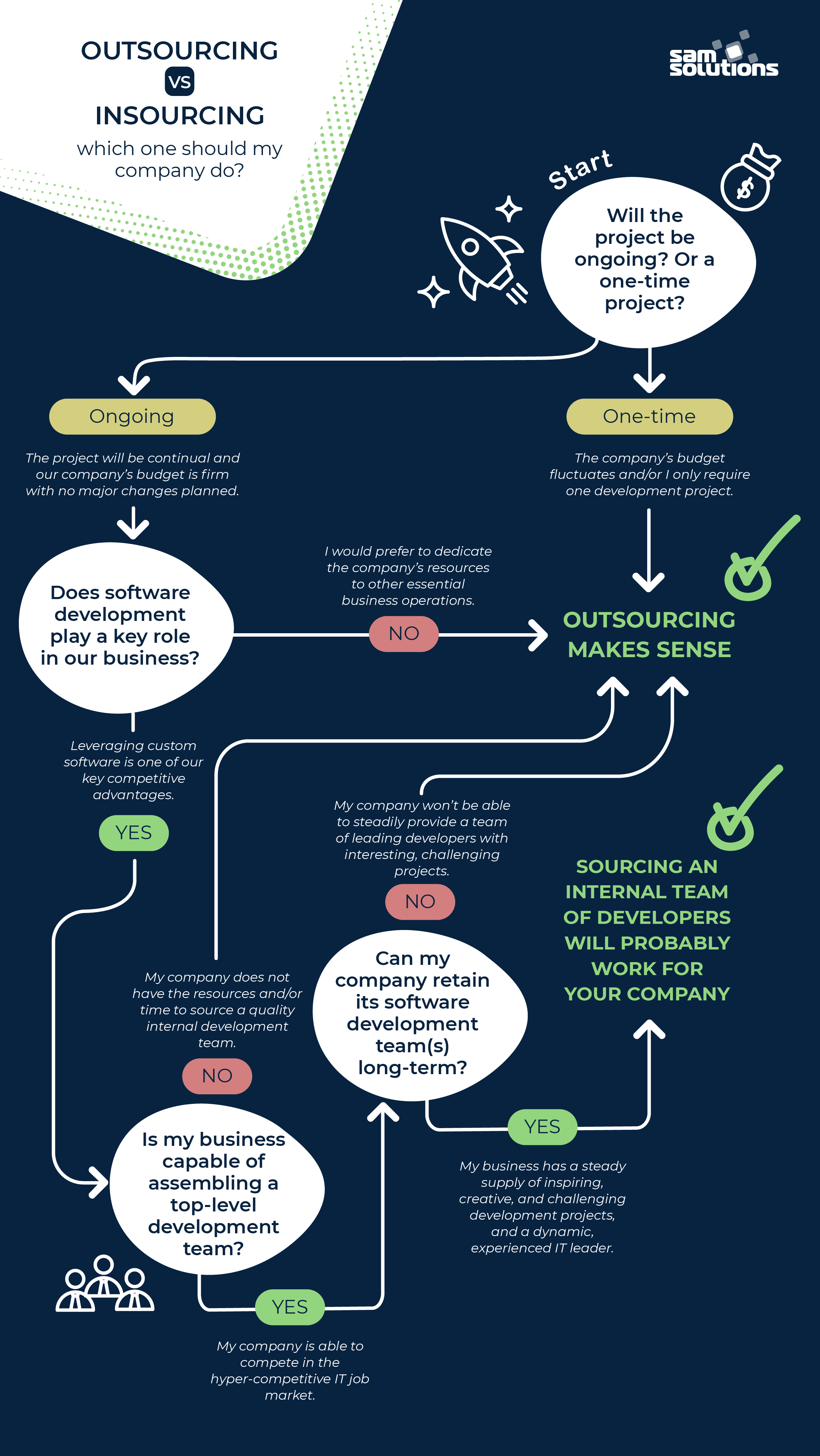
4 Major Challenges of Outsourcing Software Development
Despite the numerous benefits of outsourcing, you should not proceed unless you have weighed them against the possible risks.
First of all, you should consider communication issues which can be further divided into language/culture barriers and time zone issues.
Language/culture barriers
Software development is hard. And for a successful project you will need strong communication and a close working relationship with developers.
You can’t achieve your goals for a project without a broad discussion of what you actually need. Because of a language gap, it is quite possible for software developers to misunderstand your words, especially when you use professional jargon. Therefore, it’s essential that you choose a software development team with a strong command of the English language in order to avoid costly mistakes and delays caused by misinterpretation and ambiguities. However, the communication barriers between a customer and developers can not only relate to language but also to culture.
Time zone issues
In Agile, regular communications with developers are a reliable way to ensure the quality of your product. Therefore, if you only have a few hours a day to connect with the remote team, having their local rep/office on your speed dial is truly invaluable both for discussing the project during off hours and for reporting emergencies.
Lack of control
With software development outsourcing, you have less control over the development team than in case of insourcing. As a result, you may encounter various forms of unprofessional behavior, such as selling junior developers as seniors, charging for unnecessary work and so on.
In order to avoid such situations, it’s important to choose time-tested service providers with a solid reputation and experience in working for clients from your region.
Problems with quality
The race for cheap labor from offshore countries may end up in failure when it comes to quality. As life has it, the less you pay, the worse the result you get.
At the global level, your choice of developers is wide, and so is the variation in their quality. And if you have a business background and your knowledge of modern IT is limited, you may be unable to tell a competent developer from a bad one.
However, following a well-defined vendor selection process helps minimize these risks even in highly distributed production environments. On top of that, two years of COVID-related isolation and gradual adoption of the WFH concept has taught people to work remotely, which is why the distributed/offshore nature of your potential team should not be viewed as a major risk factor.
5 Simple Tips for Effective Software Development Outsourcing
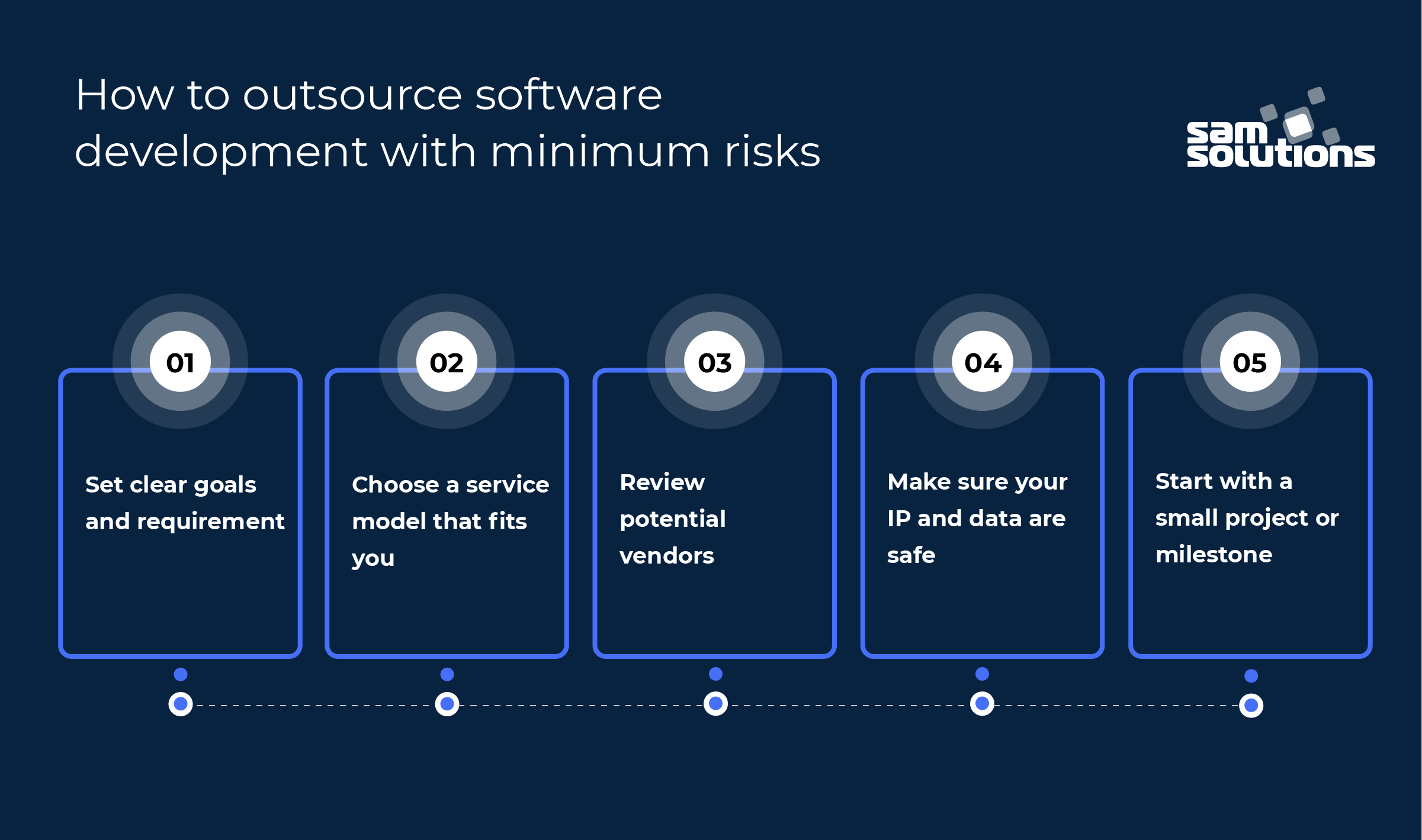
It’s no mystery that some outsourced software development projects fall apart. This can happen for a variety of reasons. Most of them are described in the section above as the challenges of software development outsourcing.
The good news is that these challenges can be avoided or managed. Here are a few things that will help you to successfully outsource your software development processes.
Most problems depend on the vendor. If you pick the right service provider, that’s half the battle. Identify potential language and communication barriers before the start of any collaboration.
The developers must not only have the necessary technical expertise but also good communication skills. It is important to hire a team that can fully understand you and ask you clear questions in spoken and written communication. This is almost impossible when a software engineer reads your instructions or specifications through Google Translate. Therefore, consider the language gap one of the deal breakers.
To begin with, you need to make sure that team members speak English or your language at a proper level. It’s a plus if the company invests in language courses for its employees or if it is located in a country where English is one of the official languages (e.g. the Philippines).
One of the best ways to assess someone’s communication skills is by having a simple conversation. Consider conducting direct interviews with potential developers via Skype or Zoom to verify that they understand you and you understand them. Opt for developers who clearly comprehend what you are saying, what you need and can articulate their thoughts on the project.
If someone is reluctant to speak to you over video, this is typically a bad sign indicating their poor credibility.
Bridge the language gap between you and developers
However, even if you choose developers with high proficiency in spoken and written English, there is still some language gap with you since they are not native speakers. You should bear it in mind and try to speak at a slow pace avoiding slang and idioms so that you can bridge the gap. Consider having video calls if you have picked a company that struggles with English for some reasons (e.g. for the lowest cost), since a picture is “worth a thousand words”. Finally, always check for understanding at the end of every call to ensure that all parties are on the same page.
One of the viable options is to make sure that only the key players on the vendor’s team speak good English. Keep in mind that you will most probably be discussing work-related matters with the project manager, business analyst and, potentially, the team’s lead engineer, so if they pass your own English proficiency test and you feel comfortable in terms of communications, you are good to go.
Conduct careful research to judge technical skills
As for the technical skills of coders you are hiring, it will be difficult or even impossible for you to check them if you have no expertise in software development. The way out for you in this situation is to thoroughly study the companies that have drawn your attention. Go through their case studies, portfolio, and customer reviews. This research is the main homework of businesses looking to outsource.
Additional food for thought can be obtained from their past collaborations. Examine their previous projects on their portfolio that are similar to yours. Assess them in terms of user-friendliness, absence of bugs and load speed. Consider estimating the quality of their code by hiring a third-party independent expert.
For more details on how to select the right vendor, please see the corresponding section below.
Start with a trial engagement
Before signing a contract for the full project, you can test the water by assigning a vendor to deliver a small part of it on a time and materials basis. This is a good way to evaluate their developers’ performance so that you can be certain of their capabilities before hiring them for the whole gig.
You can optionally hire an independent third party to evaluate the quality of the code written as part of the test project.
Use collaboration tools
Use collaboration tools like Slack, Jira, Trello, and Asana to manage your processes and bridge possible communication gaps. There is no one-size-fits-all solution to every problem, but when used in combination for the right purpose, these tools can be extremely effective. Use what works best for you or follow the vendor’s recommendations to build an effective collaboration environment and workflows.
In case of time zone differences, you can use World Time Buddy, a Google Chrome plug-in. This tool matches the daily schedules of people who need to meet and finds a time that works best for them.
3 Common Software Outsourcing Engagement Models
For successful application development outsourcing, you also need to pick the right engagement model. There are 3 most common models: Fixed Price, Time & Materials and Dedicated Team. Let’s consider them in detail.
Fixed Price
A fixed-price model means that you agree on a single, predefined amount for a specific scope of work delivered within a specific time frame.
This approach is ideal for small projects with well-defined requirements. For example, when you need to build an MPV. In this case, you move on to the next stages of development only once the previous one is finished.
For other instances, it is better to leverage the more popular agile methodology where all stages are run concurrently, with sprints addressing specific problems or functionalities, followed by the release of the most recent working version. For agile, you need to choose among Time & Materials and Dedicated Team.
Time and Materials (T&M)
Time and Materials is an approach in which you will pay for the time your development team spends on your project based on the hourly rates provided for in the contract. This is the most popular engagement model.
Dedicated Team (FTE Engagement)
Alternatively, you can simply hire software engineers to fill in specific in-house skill gaps, or you can opt for a full-fledged dedicated and self-managed team. This approach is called “dedicated team” or “FTE engagement”. It is the best fit for long-term projects.
All dedicated team members, like your in-house teams, work solely for you. The dedicated team, on the other hand, usually works remotely and full-time, reporting directly to the client.
How is software development outsourcing usually done
To begin with, you need to decide on what result you want to be delivered and estimate your budget and project timing.
Then it’s necessary to find potential contractors, evaluate them and pick the most suitable one that meets your criteria (for details, please see the section below). After agreeing on all terms, you enter into a contract with the vendor.
The development team starts working on your project. In most cases, it will require oversight on your part. This is particularly true for offshore outsourcing. So it is recommended for you to have someone on your team who will act as a dedicated project manager or product owner responsible for setting weekly targets, allocating tasks, and monitoring the progress.
Finally, you get the deliverables and check if they meet your requirements. For this purpose, you can conduct acceptance testing.
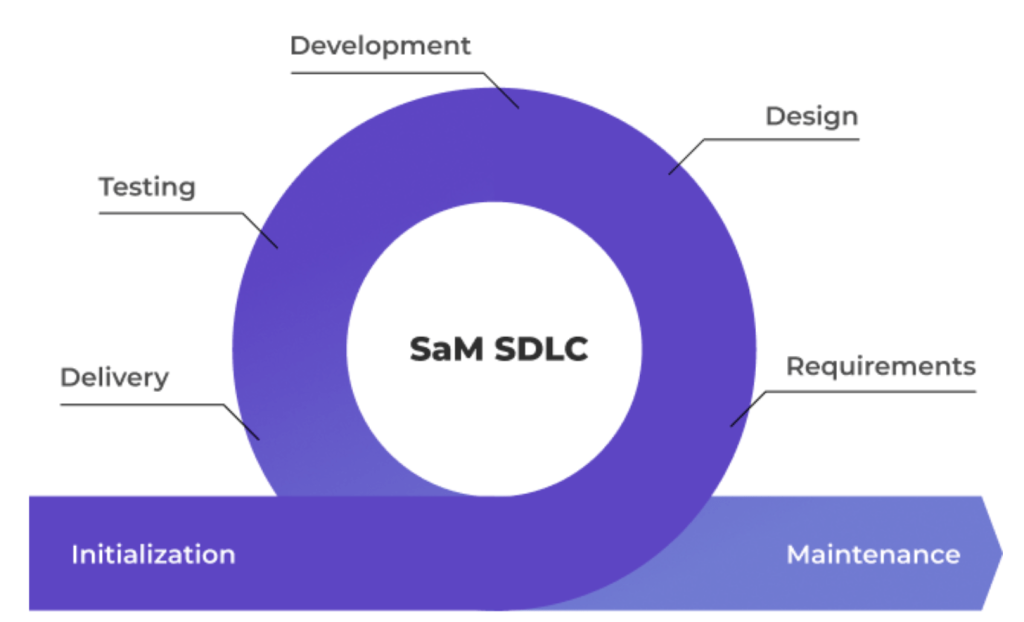
Where to order outsourcing and how much it costs
There is a wide choice of countries that you can outsource software development to. The whole world is at your disposal. For example, Latin America, Vietnam, India and the Philippines in Asia or countries in Central or Eastern Europe.
There is always a chance that you can find a development team close to you, perhaps even in the same time zone, with whom you will have a lot of overlapping hours required for successful collaboration and with whom you will be on the same page thanks to minimal cultural differences.
Alternatively, in order to save more money, you may consider remote locations that offer the cheapest rates due to the lower cost of living.
Countries may differ not only in terms of geographic location, rates or culture/mentality, but also in terms of English proficiency and engineering qualifications, etc. There are a lot of factors to consider.
The good thing is that there are rankings of software outsourcing locations created by reliable consulting firms, such as Gartner, that analyzed a wide range of parameters pertaining to various countries (like the range of services, quality and professionalism, domain expertise and others). You can find and order them on the Internet.
In particular, Gartner’s top 30 locations for offshore services, alphabetically by region, are as follows:
- Americas: Argentina, Brazil, Chile, Colombia, Costa Rica, Mexico, Peru and Uruguay
- Asia/Pacific: Bangladesh, China, India, Indonesia, Malaysia, the Philippines, Sri Lanka, Thailand and Vietnam
- Europe, the Middle East and Africa (EMEA): Belarus, Bulgaria, the Czech Republic, Hungary, Mauritius, Morocco, Poland, Romania, Russia, Slovakia, South Africa, Turkey and Ukraine
For most customers, the key factor in selecting a country is the cost of services. For your convenience, we’ve gathered hourly rates by regions in the table below based on the research by Accelerance.
| Junior Developer | Middle Developer | Senior Developer | |
| North America | $86-$150 | $110-$168 | $114-170 |
| Latin America | $34-$65 | $42-$65 | $49-82 |
| Central & Eastern Europe | $27-$65 | $40-$71 | $53-$76 |
| South Asia | $29-$41 | $35-$53 | $41-$59 |
| Southeast Asia | $26-$35 | $28-$35 | $35-$41 |
How to choose a software vendor
It goes without saying that the location of your potential development team matters a lot. However, there are plenty of other factors, such as the range of services, quality and professionalism, that may vary from company to company. You can get the worst and best possible quality for your application working with different companies in the same country.
Therefore, it is critical to find a vendor not solely based on the COUNTRY factor. Here are our recommendations on how to select your future application development outsourcing partner.
Pre-selection Process. First of all, before looking for a vendor, you need to define your requirements, possible deadlines and estimate the budget.
Now you’re ready to start your search for potential vendors. Where can you find them?
Here are some ideas:
- Request a referral from your friends/colleagues/LinkedIn network.
- Examine websites with B2B ratings and reviews like Clutch, GoodFirms, G2 (formerly known as G2 Crowd), and Softwareworld.
- Try googling. However, be aware that being on the top of search results probably means nothing but the fact that the firm has invested more money in SEO. Pay your attention to the clients list and portfolio.
Ask the candidate vendors to send you a quote for the expected development cost and time.
During the pre-selection process, you need to evaluate each developer in terms of your budget and deadlines.
Hopefully, you’ll be able to get a few potential vendors on your list.
Evaluation Process. Next, you need to reduce your list to about three strong candidates who will send you their detailed proposals. Investigate vendors by conducting preliminary interviews, with focus on their quality capabilities.
Examples of such criteria:
- technical experience
- industry knowledge
- rates
- communication skills
- readiness to sign an NDA and set up a call right away
- security
- time zone difference.
Collect the details for each vendor against relevant criteria.
Finally, you will choose one vendor that you will work together with and sign a contract for the project.
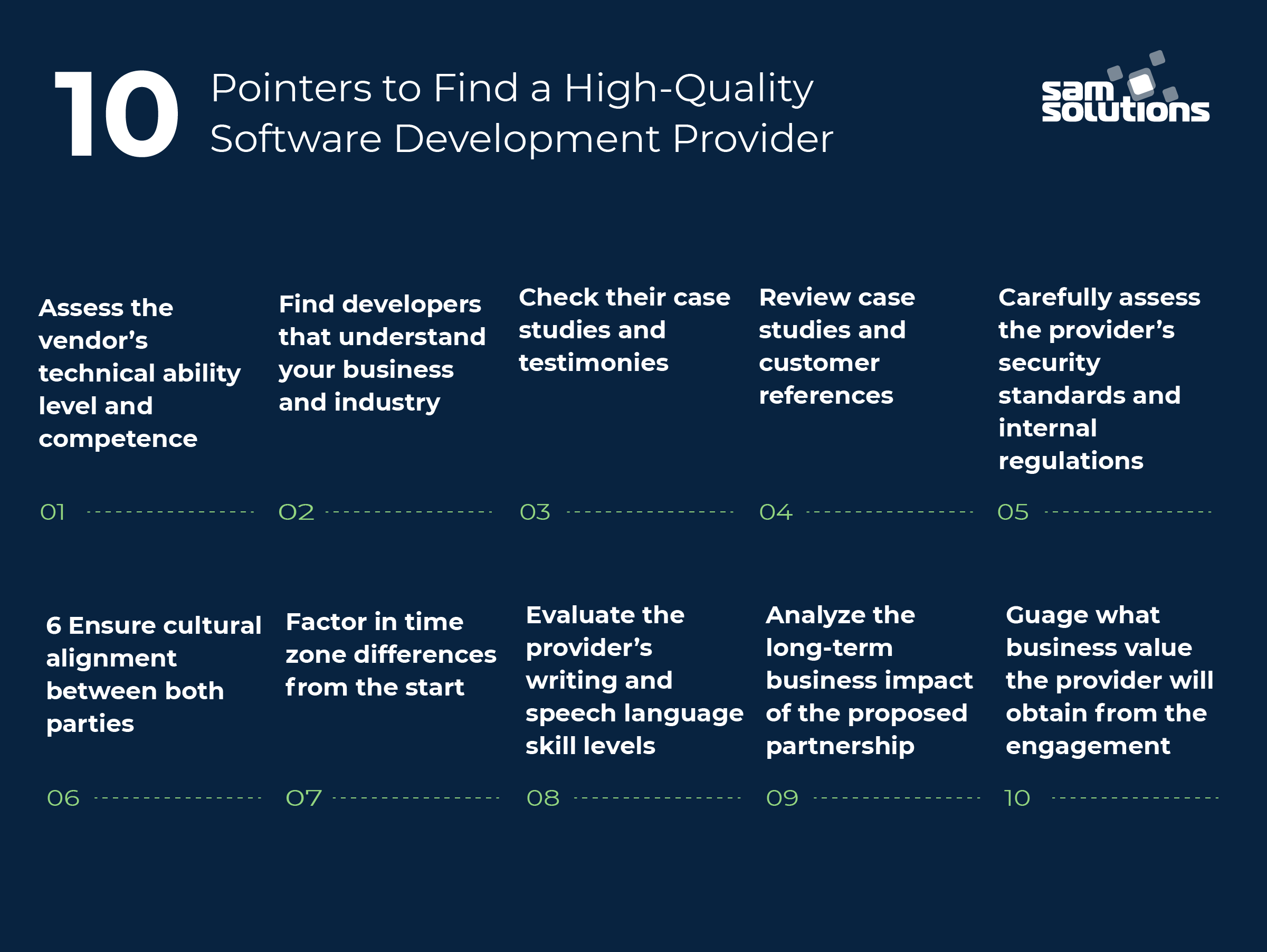
Signing a software development outsourcing contract
Now that you’ve selected a vendor, you need to sign a software development contract with them. This is necessary to protect your business if something goes wrong. Otherwise, you might end up wasting time and money in court.
What should a software development agreement include? A good contract should cover the following key points:
- Scope of work. Outline what specifically you want the vendor to do for you. Example: features to be developed, the programming language to be used, any deliverables, and the types of maintenance services required. This article of the contract usually refers to the software specifications, which are an integral part of it. The more detailed such specifications are, the better.
- Delivery schedule. What are the deadlines for each stage of the project?
- Payment terms. What is the fee, payment schedule, currency, and payment method?
- Acceptance criteria. What are the conditions that a software product must meet to be accepted by you? To assess the acceptance criteria, you need to run acceptance tests. In this regard, it is advisable to agree on the acceptance duration and potential reasons for rejection.
- Intellectual property rights. Who owns the software and code? This clause will protect you from copyright infringement.
- Confidentiality. The hired developers must maintain confidentiality. And this is not up for negotiation. The contract should specify what information is considered confidential and stipulate the vendor’s liability for disclosing it. Include a clause that requires the developers to comply with your company’s privacy policy, particularly if the project involves proprietary data, trade secrets, or sensitive customer data.
- Termination. To avoid any risk, you can provide for your option to terminate the agreement at any time if you see that the development outsourcing company is not up to the task (in this case, you need to set out the criteria, for example, two instances or more of not meeting the deadlines for milestones). Additionally, you can stipulate that the software components developed as of the termination will be kept by you.
You can find a free template of a software development contract on the Internet, for example here. However, we would not recommend relying on it fully since certain sections that you need may be missing from such a template or it may contain provisions that don’t make much sense for you. Anyway, drafting a good contract requires an experienced lawyer.
Why To Choose SaM Solutions As Your Outsourcing Partner?
If you want to build a high-quality software application, outsourcing its development is a great way to do it. Work with us and we’ll make it easy and secure.
With over 30 years of development, we built a network of offices worldwide to serve customers in different regions and time zones. In particular, our presence covers the U.S., Western Europe (Germany and the Netherlands), and Eastern Europe. Wherever you are, we are close to you and speak your language. Therefore, time zone issues and communication barriers won’t bother you during our collaboration.
At the same time, access to a large pool of IT talents at affordable rates, mostly in Eastern Europe, has enabled us to form dedicated and highly-qualified teams comprising about 800 employees with expertise in different tech areas, including:
- Business analysts
- Software engineers with a wide range of skill sets and tech stacks
- Project managers
- QA engineers (manual and automation).
We offer a wide range of services, including IT consulting, startup support and a full suite of custom software development services:
- Front-end web development (JavaScript frameworks including React, Angular, Vue js, Node.js, Knockout.js, as well as HTML/CSS)
- Back-end web development (Java, .NET, Python, Ruby, PHP, etc.)
- Mobile app development, including cross-platform development (React Native, React, Flutter, Xamarin (.NET MAUI), Apache Cordova, iOS, Android, etc.)
- Development of desktop applications (Java, C#, C++, .NET, etc.)
- COBOL.
Contact us and you won’t be disappointed. This is confirmed by over 20 of our clients with 15+ years of partnership.
Need more proof? Find our customers’ reviews on Clutch where we are rated 4.5 out of 5 and read our case studies.
Conclusion
Nowadays, the competition between businesses is fiercer than ever. As a result, it is critical that companies shift to more cost-effective business models that include outsourcing in order to stay ahead of the competition.
With the advancement of technology, more and more companies need to develop software, be it a website with a branded mobile app for customers or a desktop timesheet solution that automatically monitors employees’ performance.
Therefore, it is no surprise that software outsourcing is becoming increasingly popular, with businesses choosing to outsource their development projects for a variety of reasons, including lower development costs and quick access to a large pool of IT talent. Software outsourcing holds a lot of promise for businesses looking to gain a competitive advantage by working with a competent vendor. Don’t miss this opportunity!
FAQ
How to outsource software development?
Where to outsource software development?
Which is the best definition of the term “outsourcing”?
Why do firms outsource project work?
- Reduce costs
- Get access to a larger pool of IT talent
- Free up in-house resources for new tasks
- Improve the company’s business and/or customer focus.


